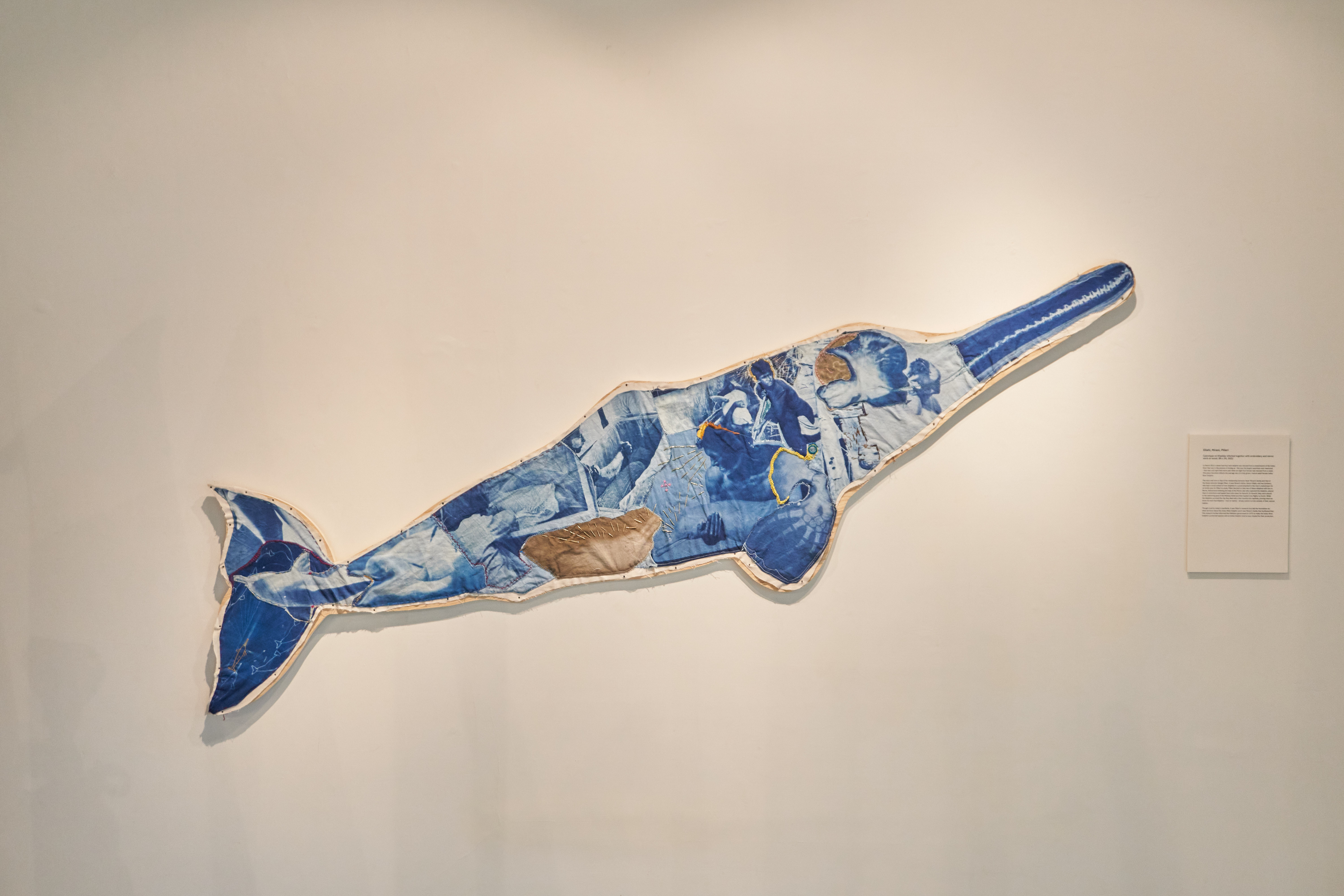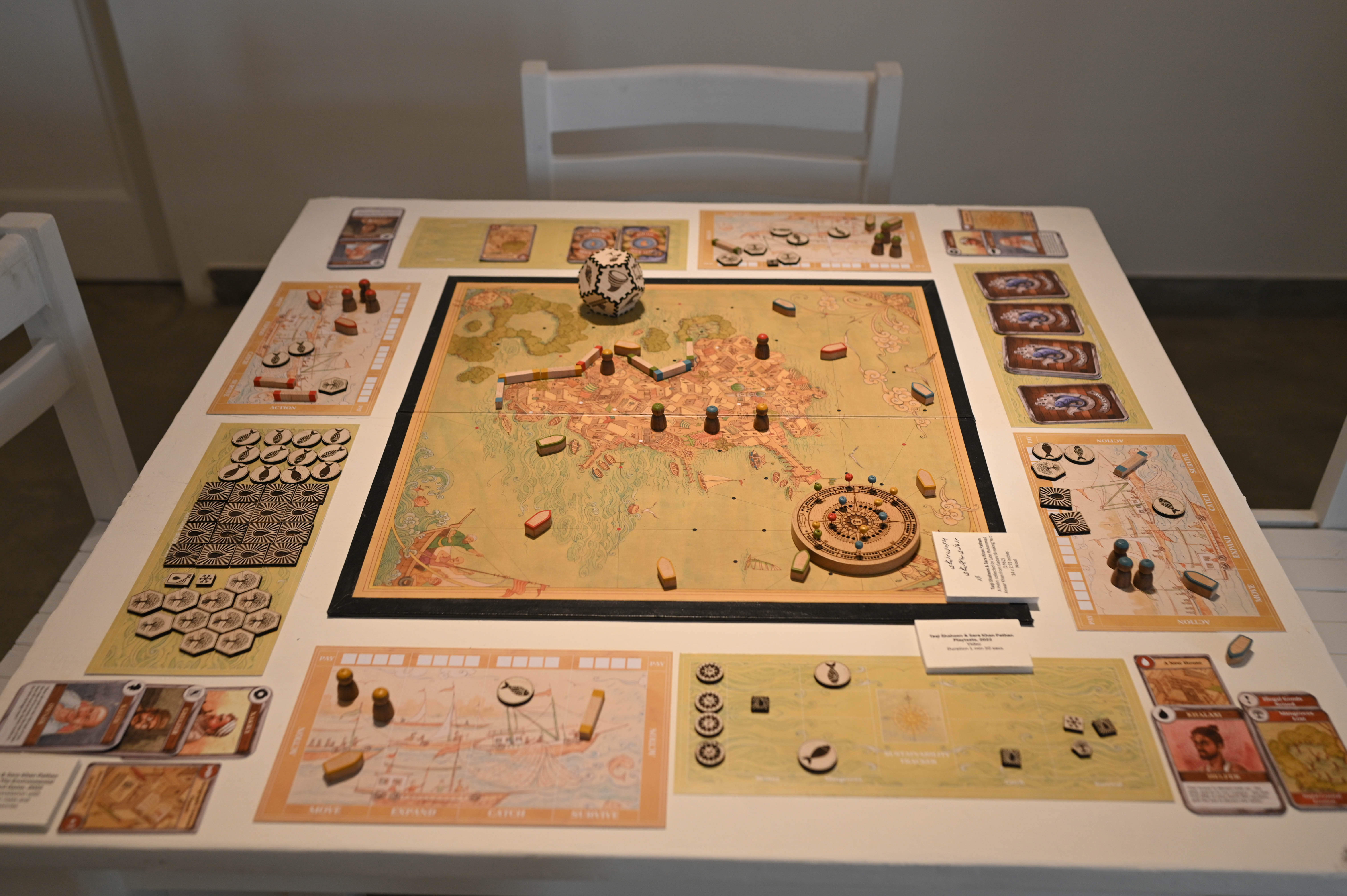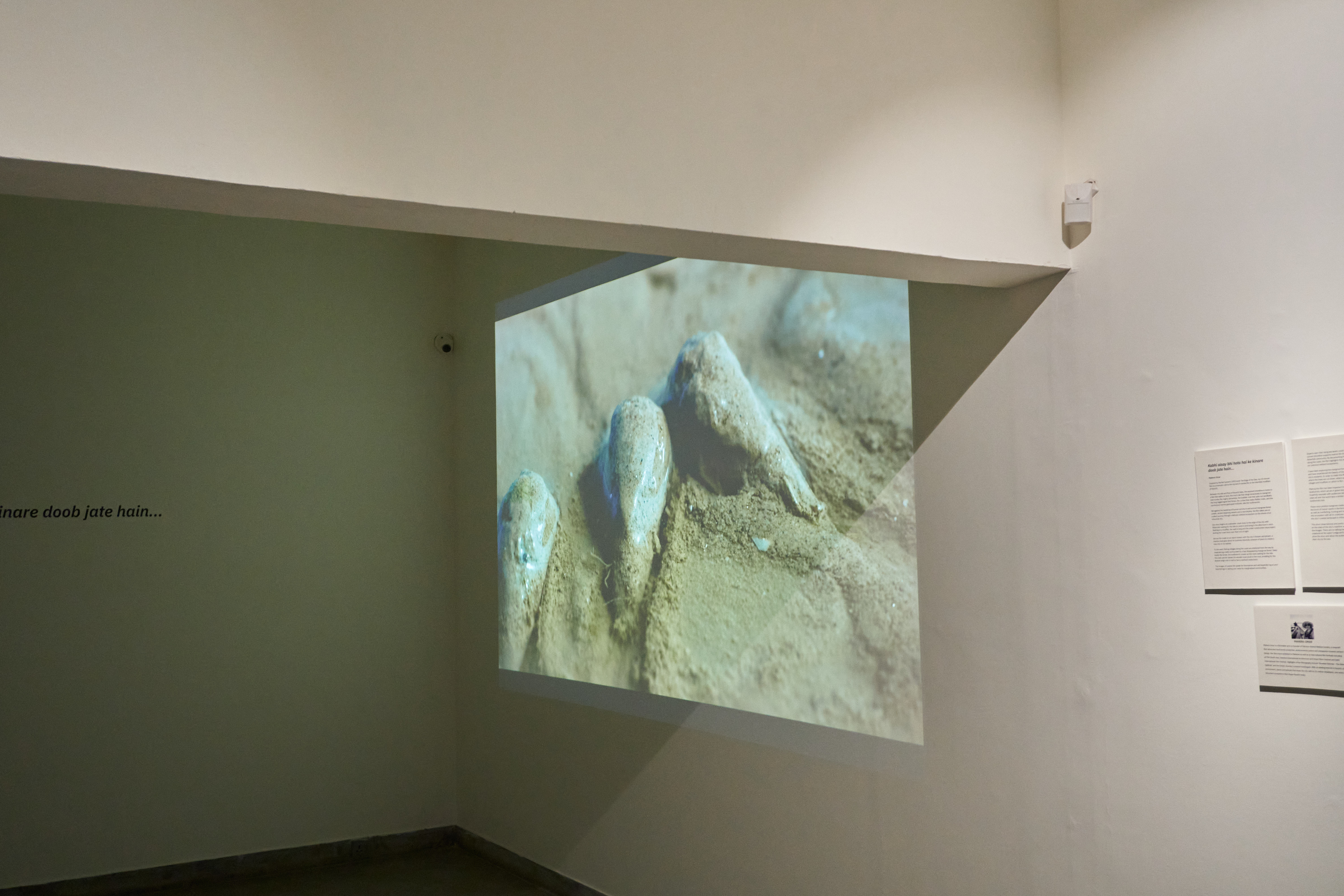The swells usher in the air, gusty, saline, alive, picking up the sand, the soil, and the earth. A topography takes shape, crafted by the air and by the sea; its ebb and flow, the sand dunes, the vegetation, the height and breadth of the plants crafted by the wind that blows. The clouds on the horizon and foam on the crests, all crafted by the wind that blows, carrying its salt and minerals from over the Arabian Sea to our shore lines, the undulating line that defines one edge of Sindh, of Karachi. A coastline that moves contiguous with the shoreline of two hundred and ten kilometers of the Indus delta. The coast breathes, its breath defining the vibrance that holds the city together.
The Karachi shoreline is unique as the mighty Indus River that starts in the foothills of the Himalayas and the Hindu Kush, curving at the Naga Parbat massif, flowing along one of the deepest gorges, across the country, over the plains of Punjab to finally reach the Indus River Delta where it empties its contents. The Delta, a unique phenomenon where the seawater meets freshwater. The silt that the River Indus carries along its long journey is deposited at end forming a slightly raised bank that allows the water to slow down and hold the mix of salt and seawater. This unique mix of salt and freshwater, home to the world’s largest arid mangrove forest as well as birds and fish and to the Indus dolphin that is only found in these waters.
The vast defining line of the coast, from the shores of the delta to the sea line, its vibrance and its health, of the people it houses and holds, Saahil ki Kahaaniyan brought together the science, the politics and stories of the people of the land and sea together in a multi- disciplinary show using film, cartography, installations, dance and photography. Curated by Noorjehan Bilgrami in collaboration with the British Council to mark the three quarter century mark of the country, the show aimed at highlighting the environmental impact of urban sprawl and the ensuing engagement with climate change. Selected was a team of four grantees from large number of applications. The British Council arranged for a Selection Committee that short-listed the chosen grantees for the show.
Pakistan is rich, with its vast topographical attributes, the mighty Himalayas, the Hindu Kush and Karakoram mountain ranges in the North, the torrential Indus River that originates there and flows right across the entire length of the country to the Arabian Sea in the South. It has rich geographical heritage and resources, with unique ecosystems that require care and consideration.
Bhulan, the Indus river dolphin is a rare species of freshwater dolphins that is only found in Pakistan. Historically they swam freely through a 3,500km stretch of the Indus River system from the Indus Estuary, through the plains, to the foothills of the Karakoram Mountains. Starting at the turn of 20th century, with the construction of dams and barrages along the Indus River, the dolphins could no longer swim freely and these structures separated their population. Compounded with the increase of the urban sprawl that has caused them to be hunted by local fisherman and the rest subject to the detrimental effects of unchecked pollution. Now most of the remaining dolphins are found in a 690km stretch of the Indus, in separated populations, most concentrated in a 410km stretch between Kotri and Guddu barrages.

Bhulan Nameh, the creation of an artist and filmmaker, is a visual compilation of their ongoing research. This series chronicled the history of the dolphins threatened habitat, the efforts undertaken for their study and conservation. Both artists hailing from Sindh bring their familiarity and connection to the land into their work. Zulfikar Ali Bhutto uses khaddar, hand embroidery and glass to evoke the feel of the land – of the warmth of the land of Sukkur. Swaths of indigo blue khaddar, hung in the middle of the gallery with cyanotype on fabric. He has used a pinhole camera to photograph the local foliage, bridges, and monuments. Mirani, a former fisherman whose family belongs to a tribe of people known as the Jabbars, one of 150 boat tribes who spent their entire lives literally on the river, rarely ever coming ashore, has spent the last half-century involved in conservation of these dolphins.
Evoking the feel of air and water, and the vision of the dolphins that are blind but can discern light and dark and vague shapes navigating through echolocation. Photography with cyanotype used by the Zulfikar encapsulates that vision. This style of photography uses sunlight for developing the image. The imagery produced is organic, with a softened edge and a layering of images that gives it a live feel, an immersive quality that engages the senses in exploration of a lyrical, mysterious and elusive image that invites engagement in its simplicity yet when has nature ever been simple. Replicated many times, in different hues of blues and ochre white, is an image of a dolphin shyly and playfully jumping out of the water, its body half submerged and half out of the water. This deceptively simple photograph is impossible to take in the murky waters of the Indus; this photograph has been appropriated from the archives of Giorgio Pilleri, a researcher from Berne, Germany who in 1970s came to study the Indus dolphins and attempted to take a few back to Berne to study. Two dolphins, a male and a female survived the long journey from Sukkur to Karachi by road and from Karachi to Germany by plane. Pilleri studied them extensively for the one year that they managed to survive in captivity. In his later years he regretted the capture and loss of lives of the dolphins he studied, yet the only known research and documentation of their habits, their lives is from his study and research.
Two other cyanotypes on khaddar scenes capture Mirani against the Lansdowne Bridge, both standing proud. Yet Mirani’s pride and dignity seems to come from having redeemed his forefathers of the hunting they used to do of the dolphins by the immense contribution he has made for their conservation. For the past half a century Mirani has used his forefather’s tracking and surveillance techniques and knowledge of the gentle animals in rescue and conservation of dolphins and to maintaining their well being in collaboration with the Sindh Wildlife Department that he works for. In a series of hand-embroidered maps in the colours and loose running stitch of the indigenous people of Sindh, the artist gave the feeling of the land. It was a little surreal seeing images, mapping done by former occupier of the subcontinent rendered in the colours of ones’ own land and culture. The psyche almost rejecting the juxtaposition yet in a way making room for ones’ own colours, the colours and textures of ones’ own people.
Janan Sindhu has spent months at a time trying to capture the gentle animals as they surface over the water. Captured by him are the dolphins as they move in their surroundings. Janan has worked to document on film the work that the Sindh Wildlife department, with the active help and involvement of the local people, do in the rescue and conservation of dolphins. Filmed and compiled in a naturalistic style, he captures the unedited colourful language, the grunting struggle as they hold the slippery struggling animal in their arms. Janan uses a naturalistic style of filming to highlight the human aspect of the interaction between man and animal, the gap of struggle; between man’s partial knowledge of nature’s great endowment, in this case the dolphin’s struggle to survive in it’s natural habitat. As the camera moves in on the anxiety of the Sindh wildlife people and the dolphins anxious flapping as it’s taken out of the water. It is a curious gap, an interval as man comes across beast, yet it’s beautiful as it completes a whole cycle, for man to be able to live with animal and nature, bringing them no harm but being a complement.
Janan has documented in another clip the reverence with which the local community of boat people have kept Giorgio Pilleri’s book ‘Secrets of the Blind Dolphin’, as they explain the background of each photo. The research in the book now a part of their lived experience and incorporated into the maintainance and well-being of the animals.
The exhibition further opened to the documentary film of Mahera Omar, a filmmaker. The coast and the land near the edge of what is called the Do Darya area was at one time not so long ago, maybe till 2005, rough and rugged. On the edge where the wild sea with its dark, surging waves would come and crash near the shore and mingle with the Korangi Creek that flowed into it. There were small inlets and beaches spread around the curve of the Do Darya and the place home to beautiful migratory birds, especially the pink flamingo the would make the shore across the creek pink in colour. Closer inland are owls, cranes and coots, and the wintergreen was accompanied by the bird calls and flapping wings of the migratory birds. The long stretch of the beaches had fine-grained sand and covered on the further edges by stretches of white, the seashells. The sand itself was never still, the tiny bubbler crabs made the sand mobile, with little sand balls in different rhythmic arrangements around their dens. They are so small that it seems as though the sand is moving by itself, yet it is this crab and their busy movements that make the beach alive.
Mahera Omer, inspired by intrepid biologist and conservationist Rachel Carson’s book ‘the Edge of the Sea ‘, documents in her ten minute clip the almost invisible marine life at the intertidal mudflats of Karachi. The cinematic style brings to life these gentle creatures on the exposed shoreline, between the ebb and flow of Karachi’ s tide. Visible only to those sitting silent, her film documents the ode of the mud crab that clings tenaciously to the mangrove tree trunks, the bubbler crab that spits out sand balls in rhythmic patterns, the fish that walks on land, the egret that fishes, the curlew that stalks fiddler crabs and the carnivorous marine gastropod mollusks.
The human activity in and around the mangrove forest creeks is as timeless and rhythmic as the diurnal movements that govern the tides jarring discordantly with the Industrial city in the background and its incessant mechanistic drone. Her film brings attention to an area as alive as us, but requiring each ones’s consideration and care.

Taqi Shaheen and Sara Khan Pathan have teamed together for the project ‘The Shape of Island’; of course the shape of any geographical mass is normally classified as a map. They have eschewed this word and in its place unpack the reality of a geographical location, in this case Bhitt Island and present a lived experience of the fisher folk community, from conversations to multigenerational stories, of how life has evolved on the island to the challenges faced, to anecdotes revealing intimate details, the team with their knack for observational details and deconstruction has taken this knowledge and reconstructed a map of a coastal community into a multiplayer environmental strategy board game . Most games are a win and lose game, ‘Zero sum games ‘ like of the countries with large GDPs.
The paradigm shift is in the word ‘environmental’. Taqi and Sara refigure reality and in the process teach sustainability, and bring awareness to what living while caring for the environment means. The board game ‘ Machi Wachi ‘ is structured not to win or lose but presents options, which either leads to Utopia, where you work to get resources and conserve them or to Dystopia, where you lose resources – A balancing act.
The artists brought their aesthetics to the physical creation of the map. Sara with a back ground in Miniature, painted the map in faded old style colours, brought to life by beautiful infinitesimal details reflecting the stories they accumulated of the life on Bhitt Island. The creation of the different components of the game was bold but the imaginative use of details ensures engagement and non-linear thought. The dice itself is not small and cuboid but larger, and octagonal in shape, made in leather with hand-stitched edges. The placement holder circular with details reminiscent of a vintage nautical compass. All the other bits wooden and boat shaped. The Shape of Island is not a just a map or a reinterpreted board game, but presents an intricate lived reality, a beautiful tool of instruction or engagement.

Marvi Mazhar an architect, Muhammad Swalay a third generation fisherman and level 8 Google Local Guide and Abuzar Madhu an artist, come together in ‘ Milaap’ where salt meets sweet water and along the way examine the axis of the mystical, ecological and industrial that cross each other along the coast of Sindh over sea, river or islands.
Through short films they present their perspectives and unravel their extensive research. In ‘Finding Khizr’, they examine the relationship of the fisherman who treats land and sea as sacred. They speak only in terms of song and geet when referring to the natural world, their sacred fields of provision. A clash with the short term Capitalist model held by developers and real estate agents, who see land and sea as extractive grounds, as economic transactions, disparate and separate whereas the fisherman sees nature and living as a whole and communal experience .The coastal communities with a population of approximately 1.25 million live entirely on their fisheries, mangroves and seafood. The fishing communities of Sindh face many issues from fishing rights to access due to national security reasons or infrastructure development that hinders their movement.
In ‘ Where is Khizr ‘ they highlight the delicate ecosystem that are under threat with the coastal development. Using Google Earth they have mapped out how once green areas along the coast no longer exist and in their stead are dry areas of land, reclaimed for housing projects.
In ‘ Ecology and Extrativism ‘ they have examined the damage and degradation resulting from sea being unable to meet the freshwater due to man made structures, creating immense damage to indigenous communities, by large areas’ increase in salinity and loss of arable land. The body of research is extensive and comes from a very personal quest to redress the immense damage to the eco-system, the poor management systems that affect water supply, violation of labour laws, loss of voice for the indigenous communities.
This important topic curated by Noorjehan Bilgrami used a multilayered approach to investigates the unique coastal ecosystem, with a to view to bringing awareness to the pressing issues of sustainable coastal development.
Asma Ahmad is a freelance writer. All information and facts provided are the sole responsibility of the writer. ‘Saahil ki kahaaniyan’ was held at the Koel Gallery from August 12 to 19, 2022
